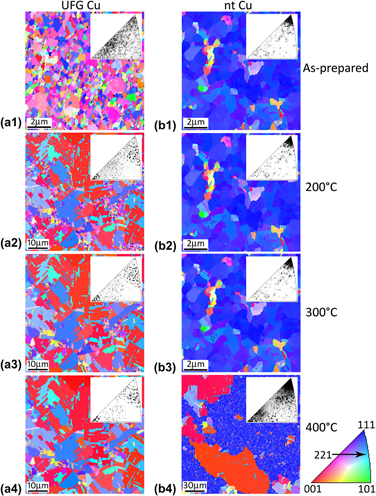Crossref Citations
This article has been cited by the following publications. This list is generated based on data provided by
Crossref.
Alimadadi, Hossein
Bastos Fanta, Alice
Somers, Marcel A. J.
and
Pantleon, Karen
2013.
Columns formed by multiple twinning in nickel layers—An approach of grain boundary engineering by electrodeposition.
Applied Physics Letters,
Vol. 103,
Issue. 3,
Furnish, T. A.
Lohmiller, J.
Gruber, P. A.
Barbee, T. W.
and
Hodge, A. M.
2013.
Temperature-dependent strain localization and texture evolution of highly nanotwinned Cu.
Applied Physics Letters,
Vol. 103,
Issue. 1,
Sagapuram, D.
Wang, Z.
and
Saldana, C.
2014.
Thermal stability of nanotwinned and nanocrystalline microstructures produced by cryogenic shear deformation.
Philosophical Magazine,
Vol. 94,
Issue. 30,
p.
3413.
Zhao, Y.
Cheng, I.C.
Kassner, M.E.
and
Hodge, A.M.
2014.
The effect of nanotwins on the corrosion behavior of copper.
Acta Materialia,
Vol. 67,
Issue. ,
p.
181.
Beyerlein, Irene J.
Zhang, Xinghang
and
Misra, Amit
2014.
Growth Twins and Deformation Twins in Metals.
Annual Review of Materials Research,
Vol. 44,
Issue. 1,
p.
329.
Chan, Tsung-Cheng
Lin, Yen-Miao
Tsai, Hung-Wei
Wang, Zhiming M.
Liao, Chien-Neng
and
Chueh, Yu-Lun
2014.
Growth of large-scale nanotwinned Cu nanowire arrays from anodic aluminum oxide membrane by electrochemical deposition process: controllable nanotwin density and growth orientation with enhanced electrical endurance performance.
Nanoscale,
Vol. 6,
Issue. 13,
p.
7332.
Borovikov, Valery
Mendelev, Mikhail I.
and
King, Alexander H.
2014.
Effects of solutes on the thermal stability of nanotwinned materials.
Philosophical Magazine,
Vol. 94,
Issue. 25,
p.
2875.
Kobler, Aaron
Hodge, Andrea M.
Hahn, Horst
and
Kübel, Christian
2015.
Orientation dependent fracture behavior of nanotwinned copper.
Applied Physics Letters,
Vol. 106,
Issue. 26,
Xue, S.
Fan, Z.
Chen, Y.
Li, J.
Wang, H.
and
Zhang, X.
2015.
The formation mechanisms of growth twins in polycrystalline Al with high stacking fault energy.
Acta Materialia,
Vol. 101,
Issue. ,
p.
62.
Velasco, Leonardo
and
Hodge, Andrea M.
2016.
The mobility of growth twins synthesized by sputtering: Tailoring the twin thickness.
Acta Materialia,
Vol. 109,
Issue. ,
p.
142.
Heckman, Nathan M.
Velasco, Leonardo
and
Hodge, Andrea M.
2016.
Influence of Twin Thickness and Grain Size on the Tensile Behavior of Fully Nanotwinned CuAl Alloys .
Advanced Engineering Materials,
Vol. 18,
Issue. 6,
p.
918.
Kim, Gyuseok
Chai, Xuzhao
Yu, Le
Cheng, Xuemei
and
Gianola, Daniel S.
2016.
Interplay between grain boundary segregation and electrical resistivity in dilute nanocrystalline Cu alloys.
Scripta Materialia,
Vol. 123,
Issue. ,
p.
113.
Wang, Jian
and
Zhang, Xinghang
2016.
Twinning effects on strength and plasticity of metallic materials.
MRS Bulletin,
Vol. 41,
Issue. 4,
p.
274.
Bufford, Daniel C.
Wang, Y. Morris
Liu, Yue
and
Lu, Lei
2016.
Synthesis and microstructure of electrodeposited and sputtered nanotwinned face-centered-cubic metals.
MRS Bulletin,
Vol. 41,
Issue. 4,
p.
286.
Cheng, Gong
Li, Heng
Xu, Gaowei
Gai, Wei
and
Luo, Le
2017.
In situ observation of nanotwins formation through twin terrace growth in pulse electrodeposited Cu films.
Scientific Reports,
Vol. 7,
Issue. 1,
Waryoba, Daudi R.
and
Roberts, Winston
2017.
Application of electromagnetic processing for development of high-performance sintered powder metal parts.
Current Applied Physics,
Vol. 17,
Issue. 10,
p.
1288.
Marro, James B.
Darroudi, Taghi
Okoro, Chukwudi A.
Obeng, Yaw S.
and
Richardson, Kathleen C.
2017.
The influence of pulse plating frequency and duty cycle on the microstructure and stress state of electroplated copper films.
Thin Solid Films,
Vol. 621,
Issue. ,
p.
91.
Heckman, Nathan M.
Velasco, Leonardo
and
Hodge, Andrea M.
2017.
Tensile behavior of fully nanotwinned alloys with varying stacking fault energies.
MRS Communications,
Vol. 7,
Issue. 2,
p.
253.
Fang, Qiongjiali
and
Sansoz, Frederic
2017.
Influence of intrinsic kink-like defects on screw dislocation – coherent twin boundary interactions in copper.
Acta Materialia,
Vol. 123,
Issue. ,
p.
383.
Ke, Xing
and
Sansoz, Frederic
2017.
Segregation-affected yielding and stability in nanotwinned silver by microalloying.
Physical Review Materials,
Vol. 1,
Issue. 6,





